Health Information Technology and Nursing Decision Making Essay
VerifiedAdded on 2022/08/17
|8
|1819
|13
Essay
AI Summary
This essay delves into the significant impact of health information technology (HIT) on nursing decision-making within healthcare settings. It identifies the nursing professional shortage as a key factor influencing these decisions, leading to potential challenges in patient assessment and care. The essay then examines wearable devices, specifically the ViSi Mobile, as a technology that can aid in addressing these challenges by providing continuous vital sign monitoring. While highlighting the benefits of such technology, including improved patient safety and timely assessments, the essay also acknowledges potential drawbacks, such as limitations in nurse-patient communication and concerns about data security. The essay concludes by emphasizing the importance of HIT in enhancing clinical decision-making but also stresses the need to address associated limitations to ensure optimal patient outcomes and maintain patient confidentiality.
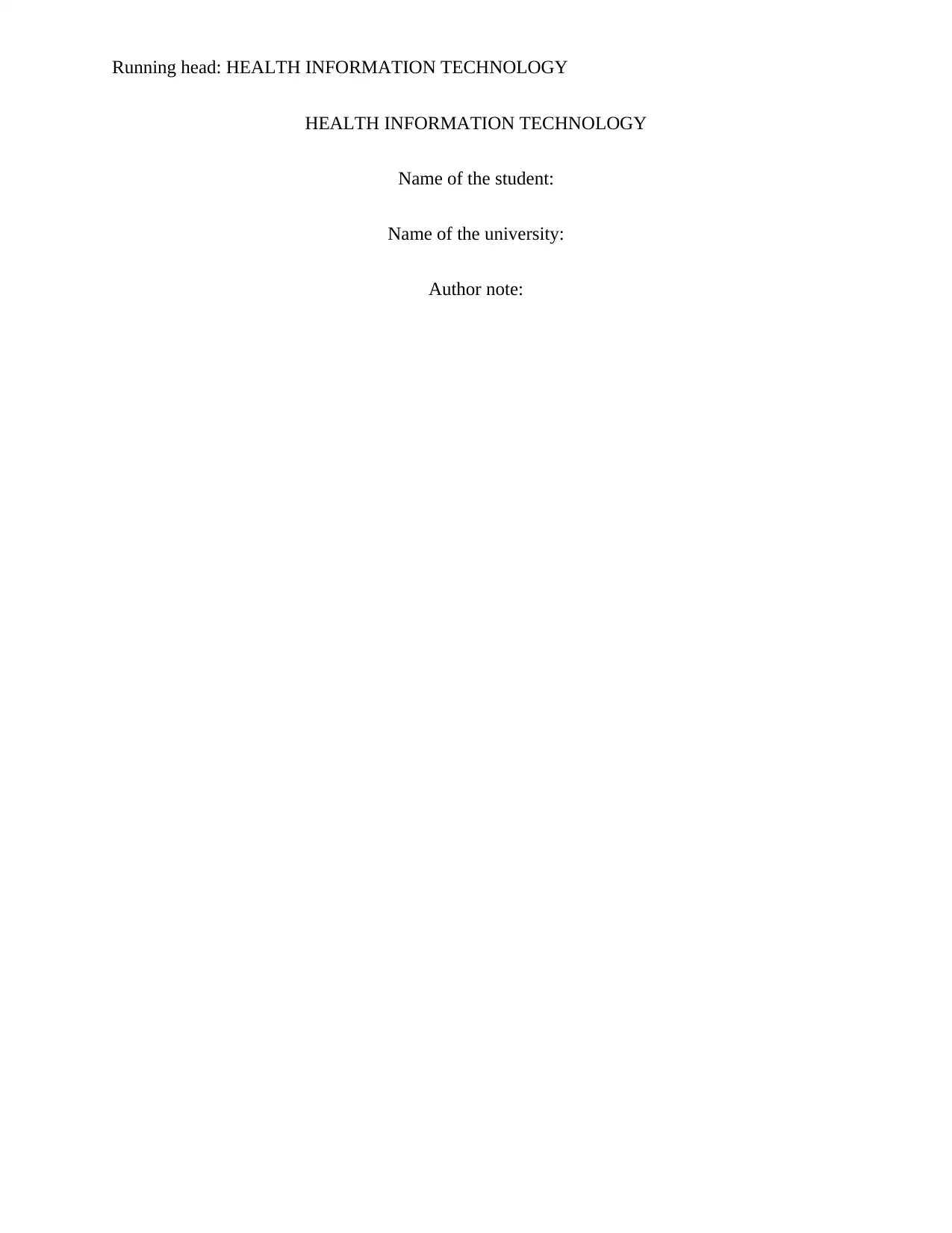
Running head: HEALTH INFORMATION TECHNOLOGY
HEALTH INFORMATION TECHNOLOGY
Name of the student:
Name of the university:
Author note:
HEALTH INFORMATION TECHNOLOGY
Name of the student:
Name of the university:
Author note:
Paraphrase This Document
Need a fresh take? Get an instant paraphrase of this document with our AI Paraphraser
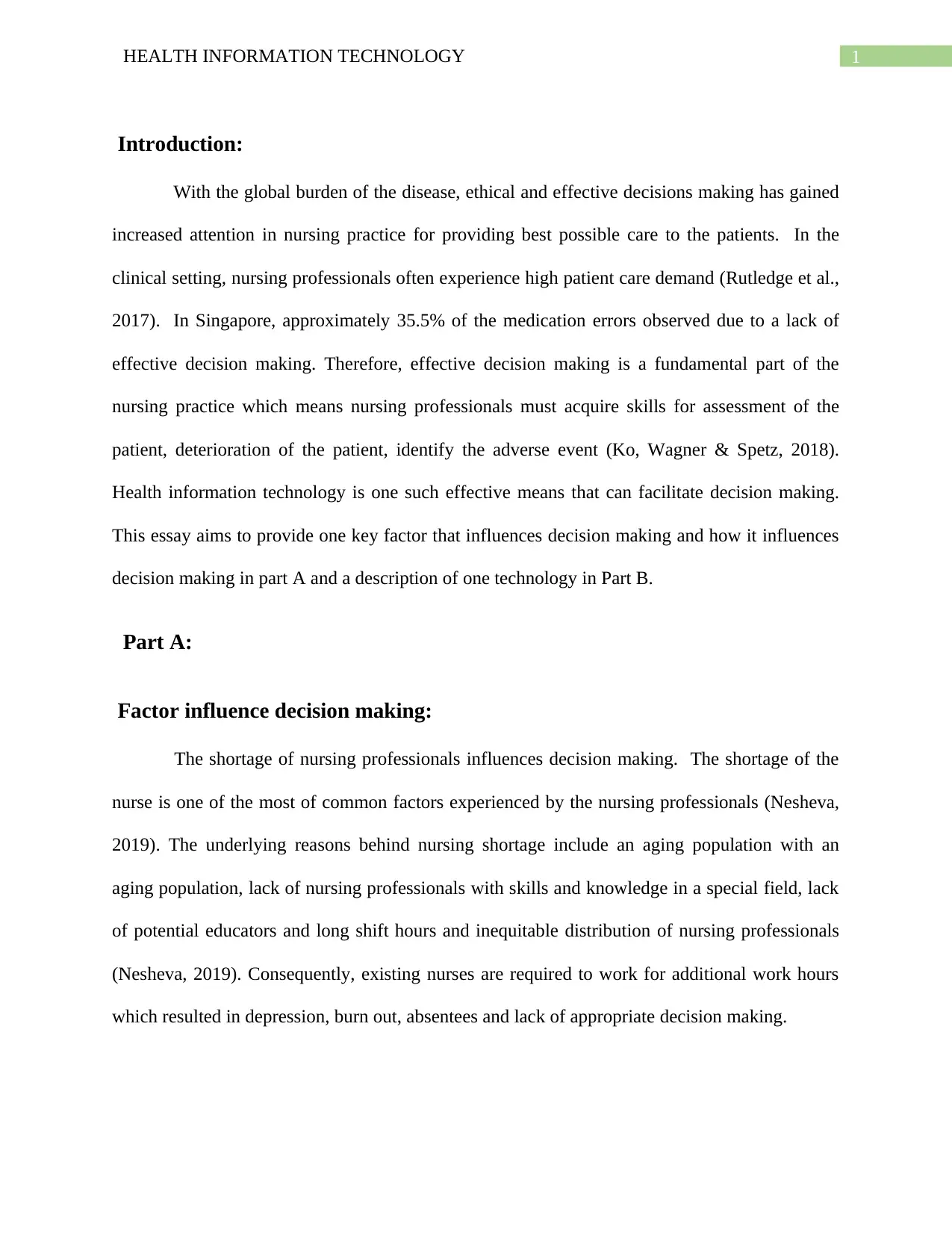
1HEALTH INFORMATION TECHNOLOGY
Introduction:
With the global burden of the disease, ethical and effective decisions making has gained
increased attention in nursing practice for providing best possible care to the patients. In the
clinical setting, nursing professionals often experience high patient care demand (Rutledge et al.,
2017). In Singapore, approximately 35.5% of the medication errors observed due to a lack of
effective decision making. Therefore, effective decision making is a fundamental part of the
nursing practice which means nursing professionals must acquire skills for assessment of the
patient, deterioration of the patient, identify the adverse event (Ko, Wagner & Spetz, 2018).
Health information technology is one such effective means that can facilitate decision making.
This essay aims to provide one key factor that influences decision making and how it influences
decision making in part A and a description of one technology in Part B.
Part A:
Factor influence decision making:
The shortage of nursing professionals influences decision making. The shortage of the
nurse is one of the most of common factors experienced by the nursing professionals (Nesheva,
2019). The underlying reasons behind nursing shortage include an aging population with an
aging population, lack of nursing professionals with skills and knowledge in a special field, lack
of potential educators and long shift hours and inequitable distribution of nursing professionals
(Nesheva, 2019). Consequently, existing nurses are required to work for additional work hours
which resulted in depression, burn out, absentees and lack of appropriate decision making.
Introduction:
With the global burden of the disease, ethical and effective decisions making has gained
increased attention in nursing practice for providing best possible care to the patients. In the
clinical setting, nursing professionals often experience high patient care demand (Rutledge et al.,
2017). In Singapore, approximately 35.5% of the medication errors observed due to a lack of
effective decision making. Therefore, effective decision making is a fundamental part of the
nursing practice which means nursing professionals must acquire skills for assessment of the
patient, deterioration of the patient, identify the adverse event (Ko, Wagner & Spetz, 2018).
Health information technology is one such effective means that can facilitate decision making.
This essay aims to provide one key factor that influences decision making and how it influences
decision making in part A and a description of one technology in Part B.
Part A:
Factor influence decision making:
The shortage of nursing professionals influences decision making. The shortage of the
nurse is one of the most of common factors experienced by the nursing professionals (Nesheva,
2019). The underlying reasons behind nursing shortage include an aging population with an
aging population, lack of nursing professionals with skills and knowledge in a special field, lack
of potential educators and long shift hours and inequitable distribution of nursing professionals
(Nesheva, 2019). Consequently, existing nurses are required to work for additional work hours
which resulted in depression, burn out, absentees and lack of appropriate decision making.
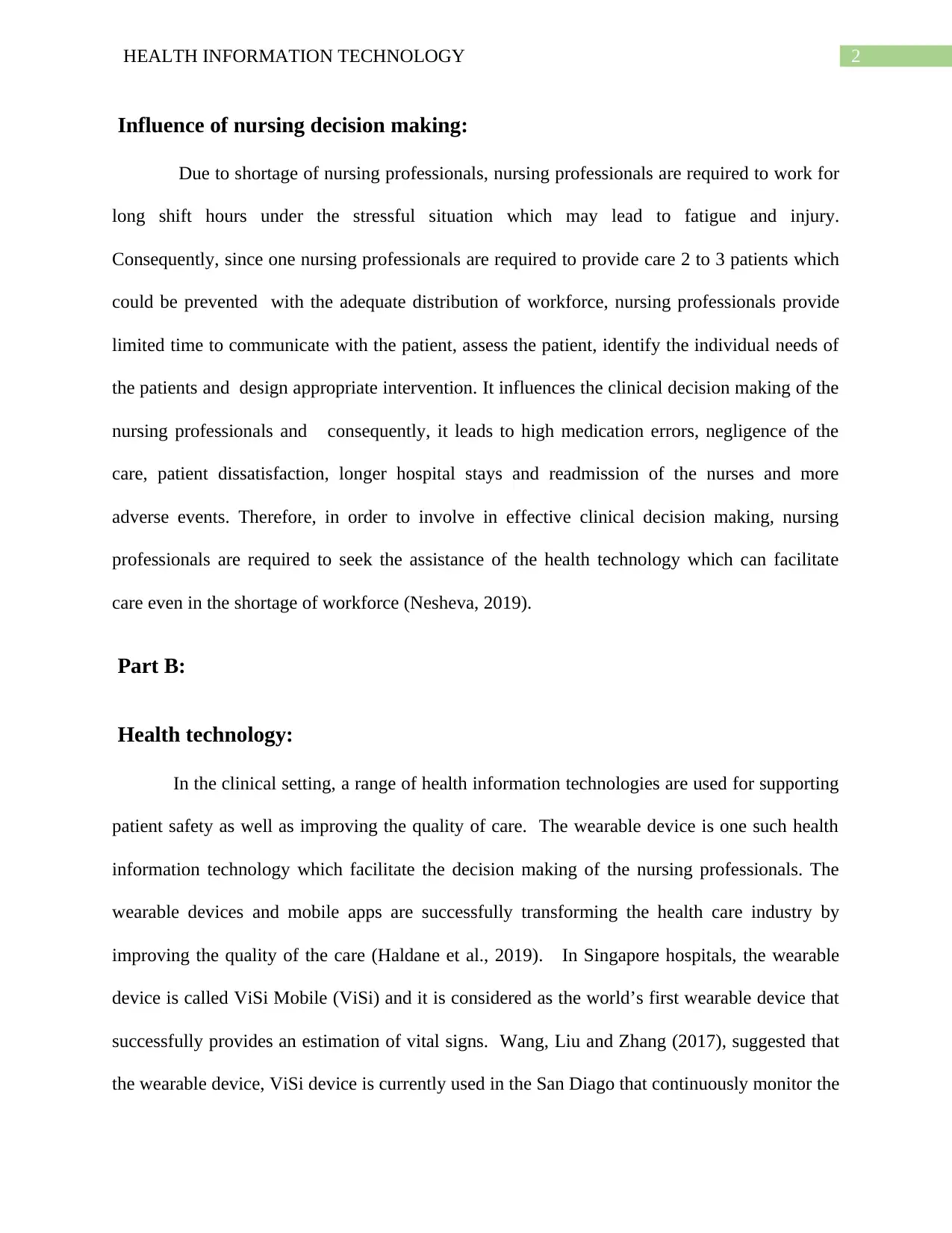
2HEALTH INFORMATION TECHNOLOGY
Influence of nursing decision making:
Due to shortage of nursing professionals, nursing professionals are required to work for
long shift hours under the stressful situation which may lead to fatigue and injury.
Consequently, since one nursing professionals are required to provide care 2 to 3 patients which
could be prevented with the adequate distribution of workforce, nursing professionals provide
limited time to communicate with the patient, assess the patient, identify the individual needs of
the patients and design appropriate intervention. It influences the clinical decision making of the
nursing professionals and consequently, it leads to high medication errors, negligence of the
care, patient dissatisfaction, longer hospital stays and readmission of the nurses and more
adverse events. Therefore, in order to involve in effective clinical decision making, nursing
professionals are required to seek the assistance of the health technology which can facilitate
care even in the shortage of workforce (Nesheva, 2019).
Part B:
Health technology:
In the clinical setting, a range of health information technologies are used for supporting
patient safety as well as improving the quality of care. The wearable device is one such health
information technology which facilitate the decision making of the nursing professionals. The
wearable devices and mobile apps are successfully transforming the health care industry by
improving the quality of the care (Haldane et al., 2019). In Singapore hospitals, the wearable
device is called ViSi Mobile (ViSi) and it is considered as the world’s first wearable device that
successfully provides an estimation of vital signs. Wang, Liu and Zhang (2017), suggested that
the wearable device, ViSi device is currently used in the San Diago that continuously monitor the
Influence of nursing decision making:
Due to shortage of nursing professionals, nursing professionals are required to work for
long shift hours under the stressful situation which may lead to fatigue and injury.
Consequently, since one nursing professionals are required to provide care 2 to 3 patients which
could be prevented with the adequate distribution of workforce, nursing professionals provide
limited time to communicate with the patient, assess the patient, identify the individual needs of
the patients and design appropriate intervention. It influences the clinical decision making of the
nursing professionals and consequently, it leads to high medication errors, negligence of the
care, patient dissatisfaction, longer hospital stays and readmission of the nurses and more
adverse events. Therefore, in order to involve in effective clinical decision making, nursing
professionals are required to seek the assistance of the health technology which can facilitate
care even in the shortage of workforce (Nesheva, 2019).
Part B:
Health technology:
In the clinical setting, a range of health information technologies are used for supporting
patient safety as well as improving the quality of care. The wearable device is one such health
information technology which facilitate the decision making of the nursing professionals. The
wearable devices and mobile apps are successfully transforming the health care industry by
improving the quality of the care (Haldane et al., 2019). In Singapore hospitals, the wearable
device is called ViSi Mobile (ViSi) and it is considered as the world’s first wearable device that
successfully provides an estimation of vital signs. Wang, Liu and Zhang (2017), suggested that
the wearable device, ViSi device is currently used in the San Diago that continuously monitor the
⊘ This is a preview!⊘
Do you want full access?
Subscribe today to unlock all pages.

Trusted by 1+ million students worldwide
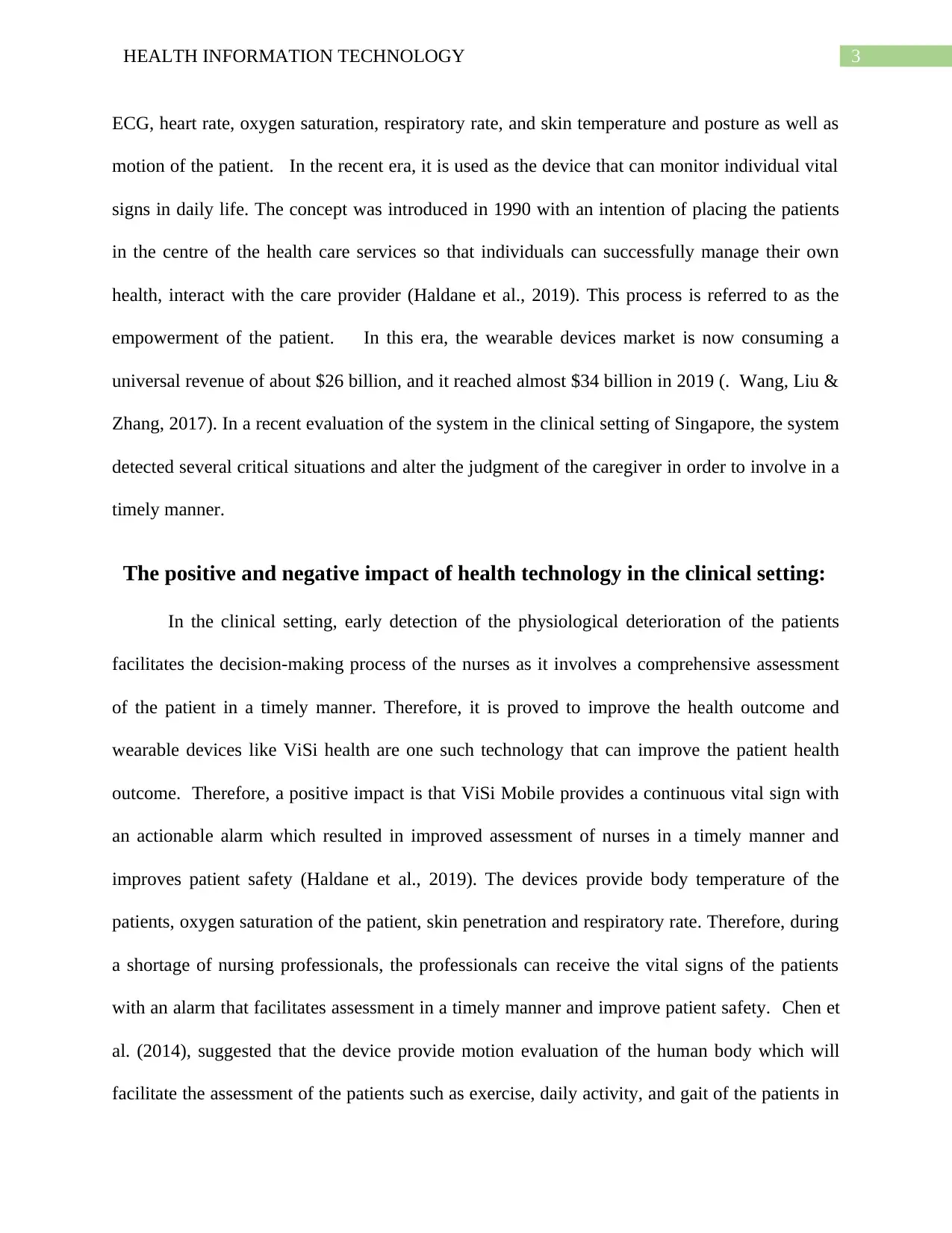
3HEALTH INFORMATION TECHNOLOGY
ECG, heart rate, oxygen saturation, respiratory rate, and skin temperature and posture as well as
motion of the patient. In the recent era, it is used as the device that can monitor individual vital
signs in daily life. The concept was introduced in 1990 with an intention of placing the patients
in the centre of the health care services so that individuals can successfully manage their own
health, interact with the care provider (Haldane et al., 2019). This process is referred to as the
empowerment of the patient. In this era, the wearable devices market is now consuming a
universal revenue of about $26 billion, and it reached almost $34 billion in 2019 (. Wang, Liu &
Zhang, 2017). In a recent evaluation of the system in the clinical setting of Singapore, the system
detected several critical situations and alter the judgment of the caregiver in order to involve in a
timely manner.
The positive and negative impact of health technology in the clinical setting:
In the clinical setting, early detection of the physiological deterioration of the patients
facilitates the decision-making process of the nurses as it involves a comprehensive assessment
of the patient in a timely manner. Therefore, it is proved to improve the health outcome and
wearable devices like ViSi health are one such technology that can improve the patient health
outcome. Therefore, a positive impact is that ViSi Mobile provides a continuous vital sign with
an actionable alarm which resulted in improved assessment of nurses in a timely manner and
improves patient safety (Haldane et al., 2019). The devices provide body temperature of the
patients, oxygen saturation of the patient, skin penetration and respiratory rate. Therefore, during
a shortage of nursing professionals, the professionals can receive the vital signs of the patients
with an alarm that facilitates assessment in a timely manner and improve patient safety. Chen et
al. (2014), suggested that the device provide motion evaluation of the human body which will
facilitate the assessment of the patients such as exercise, daily activity, and gait of the patients in
ECG, heart rate, oxygen saturation, respiratory rate, and skin temperature and posture as well as
motion of the patient. In the recent era, it is used as the device that can monitor individual vital
signs in daily life. The concept was introduced in 1990 with an intention of placing the patients
in the centre of the health care services so that individuals can successfully manage their own
health, interact with the care provider (Haldane et al., 2019). This process is referred to as the
empowerment of the patient. In this era, the wearable devices market is now consuming a
universal revenue of about $26 billion, and it reached almost $34 billion in 2019 (. Wang, Liu &
Zhang, 2017). In a recent evaluation of the system in the clinical setting of Singapore, the system
detected several critical situations and alter the judgment of the caregiver in order to involve in a
timely manner.
The positive and negative impact of health technology in the clinical setting:
In the clinical setting, early detection of the physiological deterioration of the patients
facilitates the decision-making process of the nurses as it involves a comprehensive assessment
of the patient in a timely manner. Therefore, it is proved to improve the health outcome and
wearable devices like ViSi health are one such technology that can improve the patient health
outcome. Therefore, a positive impact is that ViSi Mobile provides a continuous vital sign with
an actionable alarm which resulted in improved assessment of nurses in a timely manner and
improves patient safety (Haldane et al., 2019). The devices provide body temperature of the
patients, oxygen saturation of the patient, skin penetration and respiratory rate. Therefore, during
a shortage of nursing professionals, the professionals can receive the vital signs of the patients
with an alarm that facilitates assessment in a timely manner and improve patient safety. Chen et
al. (2014), suggested that the device provide motion evaluation of the human body which will
facilitate the assessment of the patients such as exercise, daily activity, and gait of the patients in
Paraphrase This Document
Need a fresh take? Get an instant paraphrase of this document with our AI Paraphraser
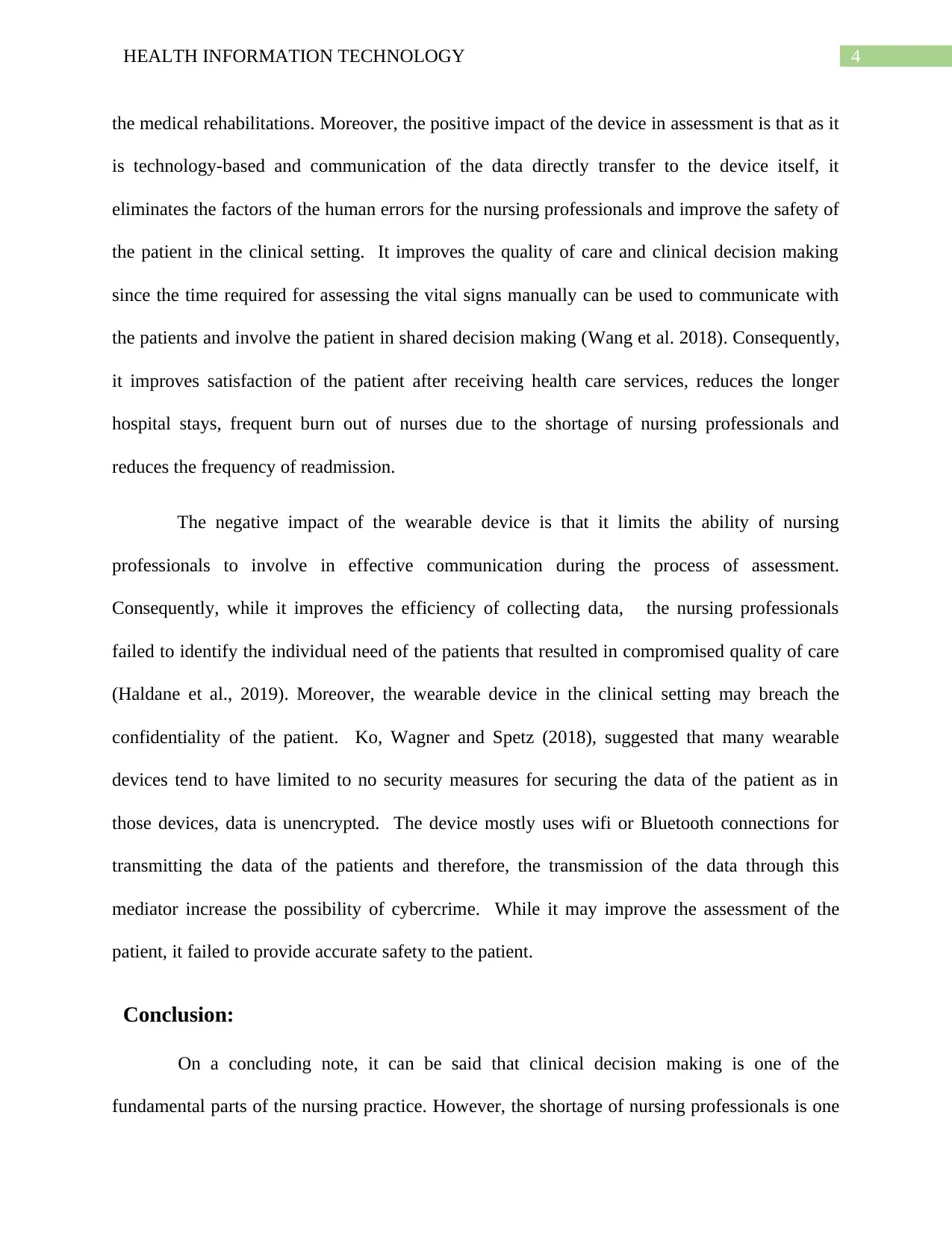
4HEALTH INFORMATION TECHNOLOGY
the medical rehabilitations. Moreover, the positive impact of the device in assessment is that as it
is technology-based and communication of the data directly transfer to the device itself, it
eliminates the factors of the human errors for the nursing professionals and improve the safety of
the patient in the clinical setting. It improves the quality of care and clinical decision making
since the time required for assessing the vital signs manually can be used to communicate with
the patients and involve the patient in shared decision making (Wang et al. 2018). Consequently,
it improves satisfaction of the patient after receiving health care services, reduces the longer
hospital stays, frequent burn out of nurses due to the shortage of nursing professionals and
reduces the frequency of readmission.
The negative impact of the wearable device is that it limits the ability of nursing
professionals to involve in effective communication during the process of assessment.
Consequently, while it improves the efficiency of collecting data, the nursing professionals
failed to identify the individual need of the patients that resulted in compromised quality of care
(Haldane et al., 2019). Moreover, the wearable device in the clinical setting may breach the
confidentiality of the patient. Ko, Wagner and Spetz (2018), suggested that many wearable
devices tend to have limited to no security measures for securing the data of the patient as in
those devices, data is unencrypted. The device mostly uses wifi or Bluetooth connections for
transmitting the data of the patients and therefore, the transmission of the data through this
mediator increase the possibility of cybercrime. While it may improve the assessment of the
patient, it failed to provide accurate safety to the patient.
Conclusion:
On a concluding note, it can be said that clinical decision making is one of the
fundamental parts of the nursing practice. However, the shortage of nursing professionals is one
the medical rehabilitations. Moreover, the positive impact of the device in assessment is that as it
is technology-based and communication of the data directly transfer to the device itself, it
eliminates the factors of the human errors for the nursing professionals and improve the safety of
the patient in the clinical setting. It improves the quality of care and clinical decision making
since the time required for assessing the vital signs manually can be used to communicate with
the patients and involve the patient in shared decision making (Wang et al. 2018). Consequently,
it improves satisfaction of the patient after receiving health care services, reduces the longer
hospital stays, frequent burn out of nurses due to the shortage of nursing professionals and
reduces the frequency of readmission.
The negative impact of the wearable device is that it limits the ability of nursing
professionals to involve in effective communication during the process of assessment.
Consequently, while it improves the efficiency of collecting data, the nursing professionals
failed to identify the individual need of the patients that resulted in compromised quality of care
(Haldane et al., 2019). Moreover, the wearable device in the clinical setting may breach the
confidentiality of the patient. Ko, Wagner and Spetz (2018), suggested that many wearable
devices tend to have limited to no security measures for securing the data of the patient as in
those devices, data is unencrypted. The device mostly uses wifi or Bluetooth connections for
transmitting the data of the patients and therefore, the transmission of the data through this
mediator increase the possibility of cybercrime. While it may improve the assessment of the
patient, it failed to provide accurate safety to the patient.
Conclusion:
On a concluding note, it can be said that clinical decision making is one of the
fundamental parts of the nursing practice. However, the shortage of nursing professionals is one
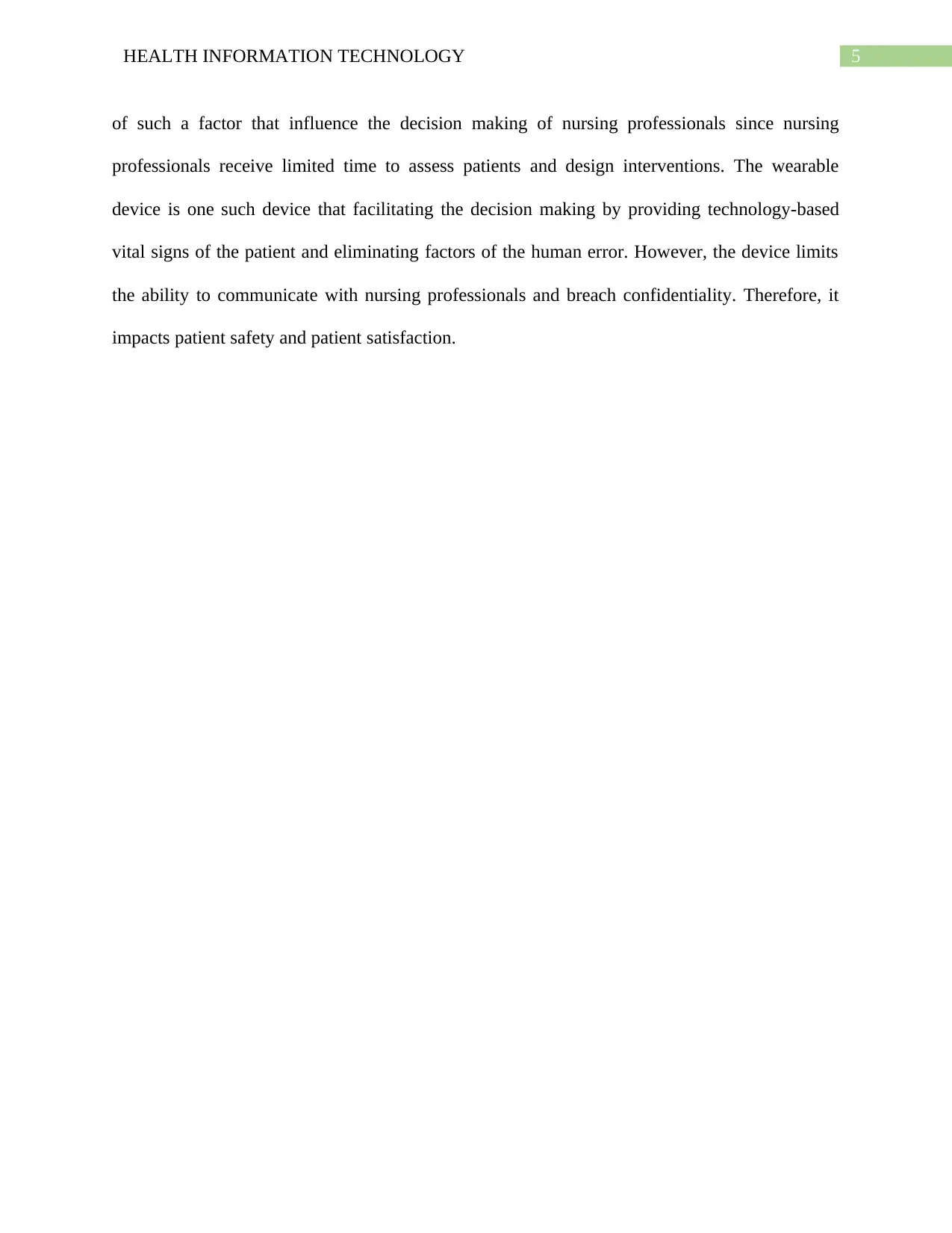
5HEALTH INFORMATION TECHNOLOGY
of such a factor that influence the decision making of nursing professionals since nursing
professionals receive limited time to assess patients and design interventions. The wearable
device is one such device that facilitating the decision making by providing technology-based
vital signs of the patient and eliminating factors of the human error. However, the device limits
the ability to communicate with nursing professionals and breach confidentiality. Therefore, it
impacts patient safety and patient satisfaction.
of such a factor that influence the decision making of nursing professionals since nursing
professionals receive limited time to assess patients and design interventions. The wearable
device is one such device that facilitating the decision making by providing technology-based
vital signs of the patient and eliminating factors of the human error. However, the device limits
the ability to communicate with nursing professionals and breach confidentiality. Therefore, it
impacts patient safety and patient satisfaction.
⊘ This is a preview!⊘
Do you want full access?
Subscribe today to unlock all pages.

Trusted by 1+ million students worldwide
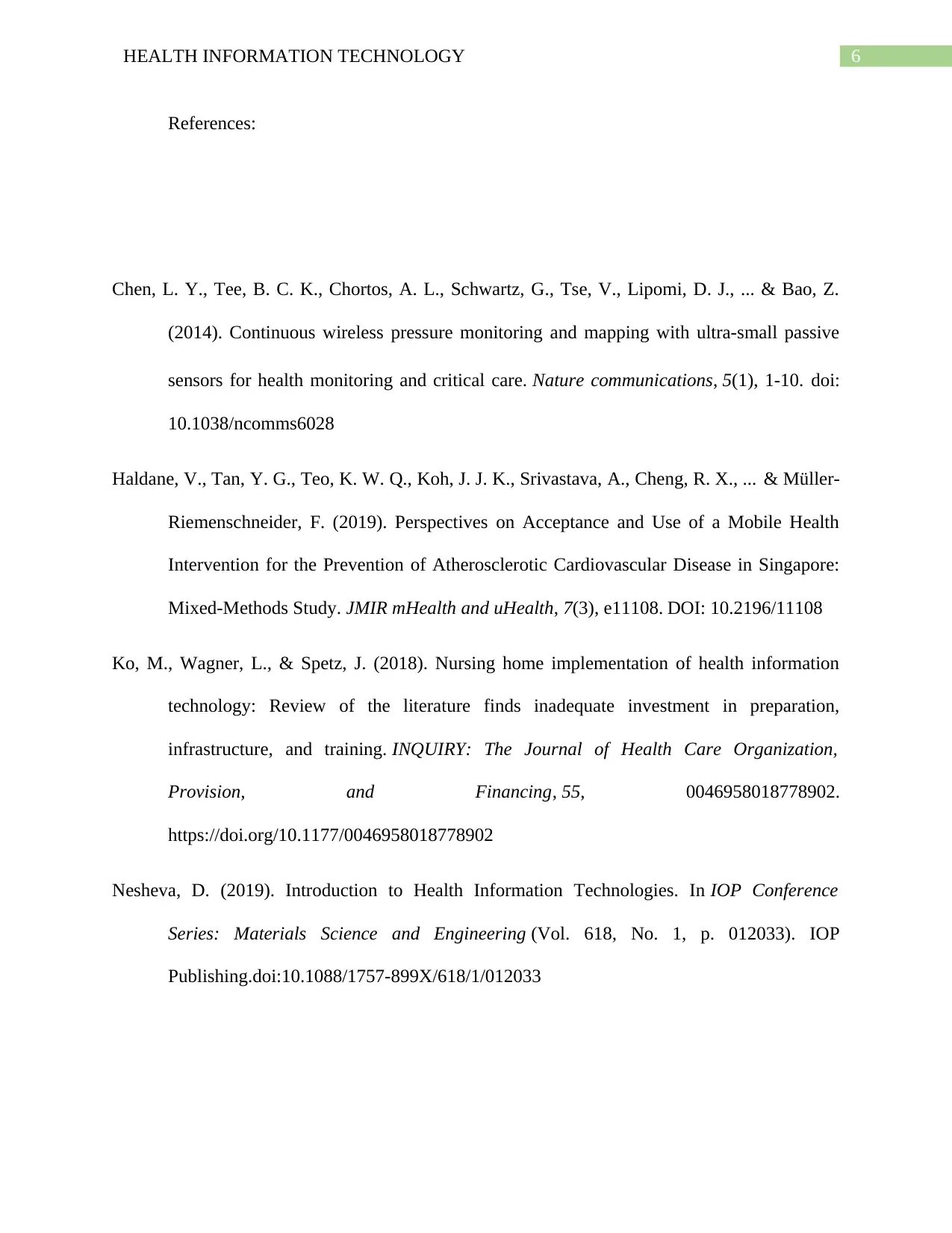
6HEALTH INFORMATION TECHNOLOGY
References:
Chen, L. Y., Tee, B. C. K., Chortos, A. L., Schwartz, G., Tse, V., Lipomi, D. J., ... & Bao, Z.
(2014). Continuous wireless pressure monitoring and mapping with ultra-small passive
sensors for health monitoring and critical care. Nature communications, 5(1), 1-10. doi:
10.1038/ncomms6028
Haldane, V., Tan, Y. G., Teo, K. W. Q., Koh, J. J. K., Srivastava, A., Cheng, R. X., ... & Müller-
Riemenschneider, F. (2019). Perspectives on Acceptance and Use of a Mobile Health
Intervention for the Prevention of Atherosclerotic Cardiovascular Disease in Singapore:
Mixed-Methods Study. JMIR mHealth and uHealth, 7(3), e11108. DOI: 10.2196/11108
Ko, M., Wagner, L., & Spetz, J. (2018). Nursing home implementation of health information
technology: Review of the literature finds inadequate investment in preparation,
infrastructure, and training. INQUIRY: The Journal of Health Care Organization,
Provision, and Financing, 55, 0046958018778902.
https://doi.org/10.1177/0046958018778902
Nesheva, D. (2019). Introduction to Health Information Technologies. In IOP Conference
Series: Materials Science and Engineering (Vol. 618, No. 1, p. 012033). IOP
Publishing.doi:10.1088/1757-899X/618/1/012033
References:
Chen, L. Y., Tee, B. C. K., Chortos, A. L., Schwartz, G., Tse, V., Lipomi, D. J., ... & Bao, Z.
(2014). Continuous wireless pressure monitoring and mapping with ultra-small passive
sensors for health monitoring and critical care. Nature communications, 5(1), 1-10. doi:
10.1038/ncomms6028
Haldane, V., Tan, Y. G., Teo, K. W. Q., Koh, J. J. K., Srivastava, A., Cheng, R. X., ... & Müller-
Riemenschneider, F. (2019). Perspectives on Acceptance and Use of a Mobile Health
Intervention for the Prevention of Atherosclerotic Cardiovascular Disease in Singapore:
Mixed-Methods Study. JMIR mHealth and uHealth, 7(3), e11108. DOI: 10.2196/11108
Ko, M., Wagner, L., & Spetz, J. (2018). Nursing home implementation of health information
technology: Review of the literature finds inadequate investment in preparation,
infrastructure, and training. INQUIRY: The Journal of Health Care Organization,
Provision, and Financing, 55, 0046958018778902.
https://doi.org/10.1177/0046958018778902
Nesheva, D. (2019). Introduction to Health Information Technologies. In IOP Conference
Series: Materials Science and Engineering (Vol. 618, No. 1, p. 012033). IOP
Publishing.doi:10.1088/1757-899X/618/1/012033
Paraphrase This Document
Need a fresh take? Get an instant paraphrase of this document with our AI Paraphraser
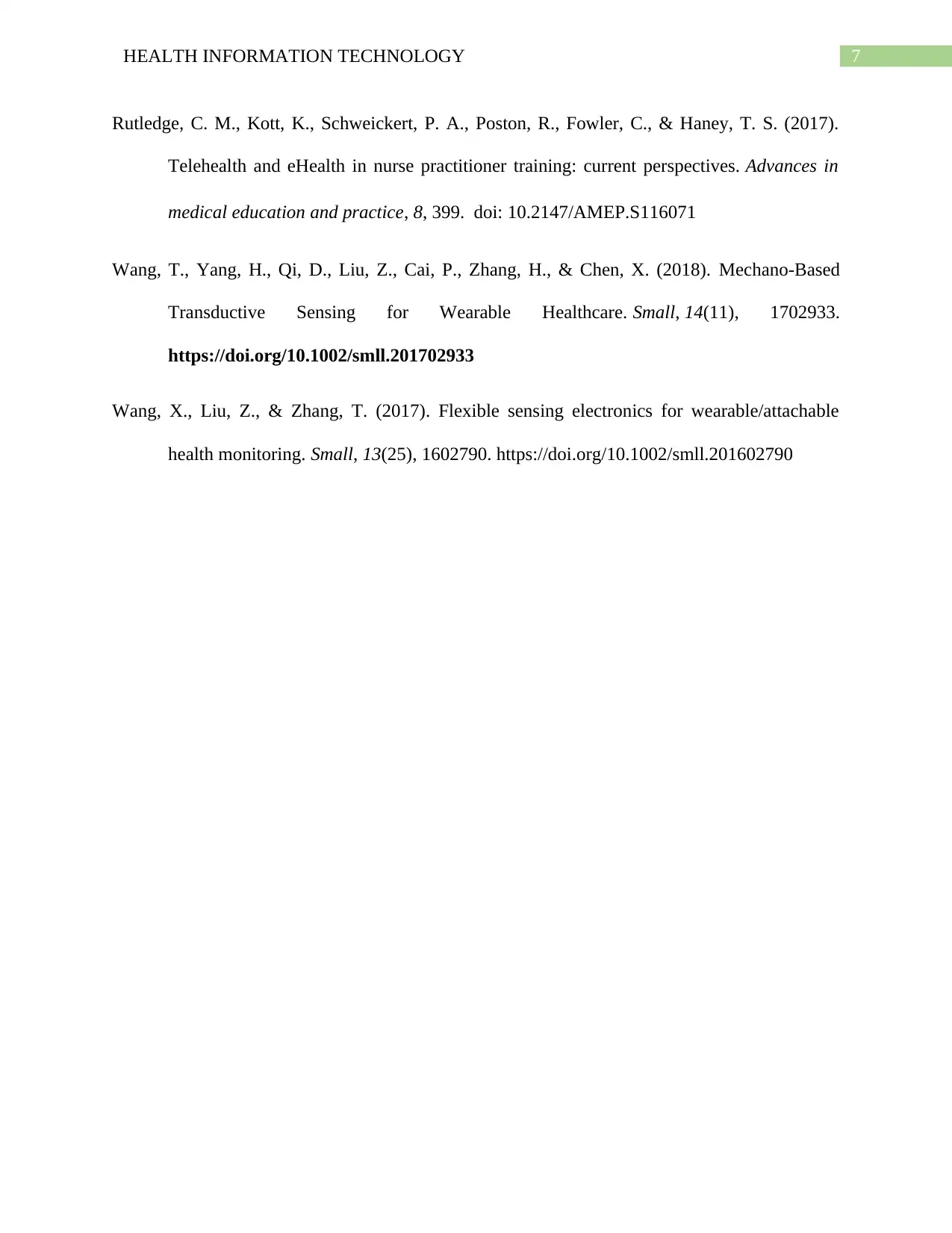
7HEALTH INFORMATION TECHNOLOGY
Rutledge, C. M., Kott, K., Schweickert, P. A., Poston, R., Fowler, C., & Haney, T. S. (2017).
Telehealth and eHealth in nurse practitioner training: current perspectives. Advances in
medical education and practice, 8, 399. doi: 10.2147/AMEP.S116071
Wang, T., Yang, H., Qi, D., Liu, Z., Cai, P., Zhang, H., & Chen, X. (2018). Mechano‐Based
Transductive Sensing for Wearable Healthcare. Small, 14(11), 1702933.
https://doi.org/10.1002/smll.201702933
Wang, X., Liu, Z., & Zhang, T. (2017). Flexible sensing electronics for wearable/attachable
health monitoring. Small, 13(25), 1602790. https://doi.org/10.1002/smll.201602790
Rutledge, C. M., Kott, K., Schweickert, P. A., Poston, R., Fowler, C., & Haney, T. S. (2017).
Telehealth and eHealth in nurse practitioner training: current perspectives. Advances in
medical education and practice, 8, 399. doi: 10.2147/AMEP.S116071
Wang, T., Yang, H., Qi, D., Liu, Z., Cai, P., Zhang, H., & Chen, X. (2018). Mechano‐Based
Transductive Sensing for Wearable Healthcare. Small, 14(11), 1702933.
https://doi.org/10.1002/smll.201702933
Wang, X., Liu, Z., & Zhang, T. (2017). Flexible sensing electronics for wearable/attachable
health monitoring. Small, 13(25), 1602790. https://doi.org/10.1002/smll.201602790
1 out of 8
Related Documents
Your All-in-One AI-Powered Toolkit for Academic Success.
+13062052269
info@desklib.com
Available 24*7 on WhatsApp / Email
![[object Object]](/_next/static/media/star-bottom.7253800d.svg)
Unlock your academic potential
Copyright © 2020–2025 A2Z Services. All Rights Reserved. Developed and managed by ZUCOL.




